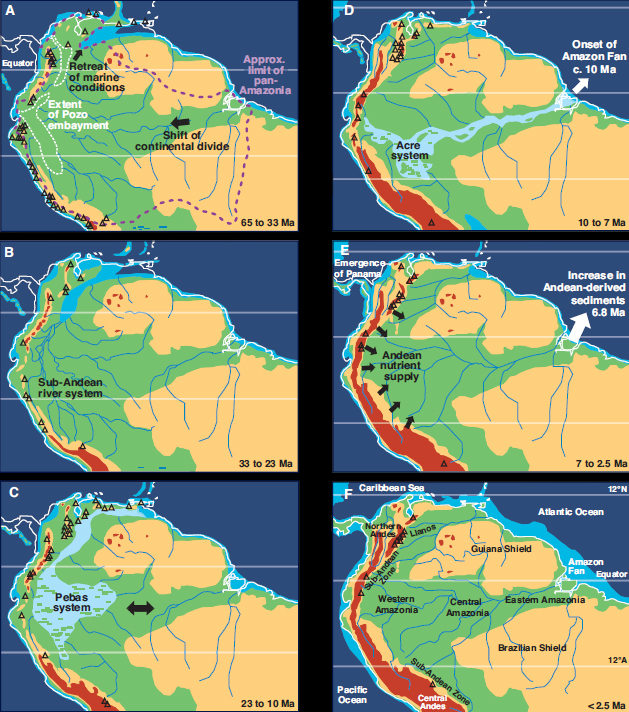This short documentary outlines a joint expedition to the Parc Amazonien de Guyane organized by
CNRS (Centre National de la Recherche Scientifique), the French Foreign Legion and Kew Botanic Gardens. The area could be rather hostile to scientists where illegal gold mines are in operation in remote and unexpected places along French Guiana-Brazil border.
As the prominent tropical biologist Stephen Hubbell described in the foreword of his book Neutral Theory of Biodiversity the state of tropical biology is still resembling to that of medicine in the middle ages. We’re still cutting bodies open (organizing expeditions) to see what organs (species) are inside. As we visit more remote places the gaps in our knowledge of Amazon flora is revealed. The entire North America harbors about roughly 300 tree species. Impressively, in the tropics, a single hectare of forest can harbor the same number of species.
Based on a curated sampling of more than half a million museum specimens collected from the Amazons over 300 years, scientists predict that about 4,000 rare types remains to be discovered. The documentary shows a classic example of collecting plant samples. Newspapers are great for “pressing” plant material until they get prepared properly in a herbarium such as the New York Botanical Garden herbarium (see video below). Kew scientist William Milliken also demonstrates sample collection for species identification using DNA from the bark of trees. Ideally, leaf is the most convenient tissue for DNA extraction but here since they are on a rapid pace expedition this is the most practical way. Milliken’s research is based on applying plant and fungal science to improve human life.
Early expeditions to tropical regions by Alexander Von Humboldt, Darwin, Henry Bates, Alfred Russell Wallace and Livingstone provided great insight and sparked curiosity. As a new continent South America was a big enigma and many explorers ventured to discover. Expeditions continue in many tropical parts of the World.
In the Amazons, over a time period spanning three centuries scientific activity accumulated more than 16000 tree species. This endeavor was started by Carl Friedrich Philipp von Martius (1794–1868). Through an expedition that lasted four years (1817–1821) he traveled with zoologist Johann Baptist von Spix (1781–1826) he travelled from Rio de Janeiro to São Paulo to Belém. They went up the Amazon River by canoe. The team traveled 10,000 km and made 3,541 collections of birds, insects, and other animals. The plants were comprised of 25,000–30,000 pressed herbarium specimens. These specimens were identified to correspond ca. 7,300 plant species. All of their collection is stored at the Botanische Staatssammlung München. The ambitious Flora Brasiliensis Project was started by work of von Martius containing 22,767 species.
There are many online resources for identification and characterization of Neotropical flora: IPNI the International Plant Names Index, TROPICOS the Missouri Botanical Garden’s electronic database, ATDN the Amazon Tree Diversity Network, the Dutch natural history collection Naturalis’ Bioportal, are a few examples. A collaborative project by MNHN-Paris and IRD-Cayenne in France called e-ReColNat project is also a significant resource for referencing Amazonia biodiversity. Field guides from the Field Museum of Chicago are another resource for tree identification. Perhaps the most informative website about Amazonian tree species is the Amazonian Tree Flora Platform where descriptions, visuals and genetic resources are deposited for researchers. Another handy resource for identification of Central American trees of which majority of them also occur in the Amazons is the book Trees of Panama and Costa Rica.
Geology of South America especially formation of the Andes mountain range has had a huge influence on evolution of life in this continent. Darwin witnessed a a strong earthquake in Valdivia of Chili. Survey instruments on board Beagle measured that the some parts of the coastline elevated 8 feet. Darwin’s understanding of geological forces changing the crust of the planet became solid.
The formation of the Andes mountain range began with the events of the Triassic when Pangaea began to break up and several rifts developed. It still continues today. During the Cretaceous Period the Andes began to take its present form, through the uplifting, faulting and folding of sedimentary and metamorphic rocks of the ancient cratons to the east of the continent. The range has many active volcanoes, which are distributed along four volcanic zones. The volcano Chimborazo in the Ecuadorean Andes is farther from Earth’s center than any other location on Earth’s surface, due to the equatorial bulge resulting from the rotation of our planet. Andes changed the entire Amazon Basin over tens of millions of years.
In addition to mountain building, there is also another competing hypothesis called “marine incursion” seeking to explain the extraordinary biological diversity in the Amazons. The hypothesis states that before the Amazon River formed there was a massive shallow sea that created many isolated islands. This shallow incursion may have receded many times. In this way, species evolved in isolation was “pumped” into the Amazon basin until the next cycle of incursion. Strictly freshwater species of piranhas may have evolved through such incursion cycles.
Both competing hypothesis are gathering data using genetic structure of tree populations and geological core samples.



0 Comments
You can be the first one to leave a comment.